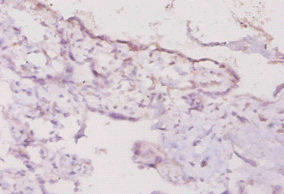Description
| Antibody Name: | Ifng Antibody (PACO33624) |
| Antibody SKU: | PACO33624 |
| Size: | 50ug |
| Host Species: | Rabbit |
| Tested Applications: | ELISA, IHC |
| Recommended Dilutions: | ELISA:1:2000-1:10000, IHC:1:10-1:100 |
| Species Reactivity: | Mouse |
| Immunogen: | Recombinant Mouse Interferon γ protein (27-155AA) |
| Form: | Liquid |
| Storage Buffer: | Preservative: 0.03% Proclin 300 Constituents: 50% Glycerol, 0.01M PBS, PH 7.4 |
| Purification Method: | >95%, Protein G purified |
| Clonality: | Polyclonal |
| Isotype: | IgG |
| Conjugate: | Non-conjugated |
 | Immunohistochemistry of paraffin-embedded human placenta tissue using PACO33624 at dilution of 1:20. |
| Background: | Produced by lymphocytes activated by specific antigens or mitogens. IFN-gamma, in addition to having antiviral activity, has important immunoregulatory functions. It is a potent activator of macrophages, it has antiproliferative effects on transformed cells and it can potentiate the antiviral and antitumor effects of the type I interferons. |
| Synonyms: | Interferon γ (IFN-gamma), Ifng |
| UniProt Protein Function: | IFNG: Produced by lymphocytes activated by specific antigens or mitogens. IFN-gamma, in addition to having antiviral activity, has important immunoregulatory functions. It is a potent activator of macrophages, it has antiproliferative effects on transformed cells and it can potentiate the antiviral and antitumor effects of the type I interferons. Homodimer. Released primarily from activated T lymphocytes. Belongs to the type II (or gamma) interferon family. |
| UniProt Protein Details: | Protein type:Membrane protein, integral; Cytokine; Secreted, signal peptide; Secreted Cellular Component: external side of plasma membrane; extracellular region; extracellular space; intracellular Molecular Function:cytokine activity; interferon-gamma receptor binding; protein binding Biological Process: adaptive immune response; antigen processing and presentation; apoptosis; CD8-positive, alpha-beta T cell differentiation during immune response; cell cycle arrest; defense response to bacterium; defense response to protozoan; defense response to virus; humoral immune response; immune response; inflammatory cell apoptosis; negative regulation of cell proliferation; negative regulation of epithelial cell differentiation; negative regulation of interleukin-17 production; negative regulation of myelination; negative regulation of smooth muscle cell proliferation; negative regulation of transcription from RNA polymerase II promoter; neutrophil apoptosis; neutrophil chemotaxis; positive regulation of autophagy; positive regulation of CD4-positive, CD25-positive, alpha-beta regulatory T cell differentiation during immune response; positive regulation of cell adhesion; positive regulation of cell proliferation; positive regulation of chemokine biosynthetic process; positive regulation of interleukin-1 beta secretion; positive regulation of interleukin-12 biosynthetic process; positive regulation of interleukin-12 production; positive regulation of interleukin-23 production; positive regulation of interleukin-6 biosynthetic process; positive regulation of isotype switching to IgG isotypes; positive regulation of killing of cells of another organism; positive regulation of membrane protein ectodomain proteolysis; positive regulation of MHC class II biosynthetic process; positive regulation of neuron differentiation; positive regulation of nitric oxide biosynthetic process; positive regulation of osteoclast differentiation; positive regulation of peptidyl-serine phosphorylation of STAT protein; positive regulation of synaptic transmission, cholinergic; positive regulation of T cell proliferation; positive regulation of transcription from RNA polymerase II promoter; positive regulation of transcription, DNA-dependent; positive regulation of tumor necrosis factor production; positive regulation of tyrosine phosphorylation of Stat1 protein; protein import into nucleus, translocation; regulation of growth; regulation of immune response; regulation of insulin secretion; regulation of the force of heart contraction; regulation of transcription, DNA-dependent; response to virus; sensory perception of mechanical stimulus; T cell receptor signaling pathway; unfolded protein response |
| NCBI Summary: | This gene encodes a soluble cytokine that is a member of the type II interferon class. The encoded protein is secreted by cells of both the innate and adaptive immune systems. The active protein is a homodimer that binds to the interferon gamma receptor which triggers a cellular response to viral and microbial infections. Mice deficient in this gene have increased susceptibility to viral, bacterial and parasitic infections and to several autoimmune diseases. [provided by RefSeq, Dec 2015] |
| UniProt Code: | P01580 |
| NCBI GenInfo Identifier: | 124480 |
| NCBI Gene ID: | 15978 |
| NCBI Accession: | P01580.1 |
| UniProt Secondary Accession: | P01580,Q542B8, |
| UniProt Related Accession: | P01580 |
| Molecular Weight: | 17,907 Da |
| NCBI Full Name: | Interferon gamma |
| NCBI Synonym Full Names: | interferon gamma |
| NCBI Official Symbol: | Ifng |
| NCBI Official Synonym Symbols: | Ifg; IFN-g |
| NCBI Protein Information: | interferon gamma |
| UniProt Protein Name: | Interferon gamma |
| Protein Family: | Interferon |
| UniProt Gene Name: | Ifng |
| UniProt Entry Name: | IFNG_MOUSE |
| Secondary Antibody |
| Anti-HRP Goat Anti-Rabbit IgG (H+L) Antibody (CABS014) |
| Recommended Products |
| Anti-FITC Goat Anti-Rabbit IgG (H+L) Antibody (CABS011) |
| Anti-HRP-conjugated Beta Actin Antibody (CABC028) |






